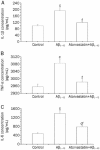Atorvastatin prevents amyloid-β peptide oligomer-induced synaptotoxicity and memory dysfunction in rats through a p38 MAPK-dependent pathway
- PMID: 24793311
- PMCID: PMC4086387
- DOI: 10.1038/aps.2013.203
Atorvastatin prevents amyloid-β peptide oligomer-induced synaptotoxicity and memory dysfunction in rats through a p38 MAPK-dependent pathway
Abstract
Aim: To investigate whether atorvastatin treatment could prevent Aβ1-42 oligomer (AβO)-induced synaptotoxicity and memory dysfunction in rats, and to elucidate the mechanisms involved in the neuroprotective actions of atorvastatin.
Methods: SD rats were injected with AβOs (5 nmol, icv). The rats were administrated with atorvastatin (10 mg·kg(-1)·d(-1), po) for 2 consecutive weeks (the first dose was given 5 d before AβOs injection). The memory impairments were evaluated with Morris water maze task. The expression of inflammatory cytokines in the hippocampus was determined using ELISA assays. The levels of PSD-95 and p38MAPK proteins in rat hippocampus were evaluated using Western blot analysis. For in vitro experiments, cultured rat hippocampal neurons were treated with AβOs (50 nmol/L) for 48 h. The expression of MAP-2 and synaptophysin in the neurons was detected with immunofluorescence.
Results: The AβO-treated rats displayed severe memory impairments in Morris water maze tests, and markedly reduced levels of synaptic proteins synaptophysin and PSD-95, increased levels of inflammatory cytokines (IL-1β, IL-6 and TNF-α) and p38MAPK activation in the hippocampus. All these effects were prevented or substantially attenuated by atorvastatin administration. Pretreatment of cultured hippocampal neurons with atorvastatin (1 and 5 μmol/L) concentration-dependently attenuated the AβO-induced synaptotoxicity, including the loss of dendritic marker MAP-2, and synaptic proteins synaptophysin and PSD-95. Pretreatment of the cultured hippocampal neurons with the p38MAPK inhibitor SB203580 (5 μmol/L) blocked the AβO-induced loss of synaptophysin and PSD-95.
Conclusion: Atorvastatin prevents AβO-induced synaptotoxicity and memory dysfunction through a p38MAPK-dependent pathway.
Figures







Similar articles
-
Atorvastatin prevents Aβ oligomer-induced neurotoxicity in cultured rat hippocampal neurons by inhibiting Tau cleavage.Acta Pharmacol Sin. 2015 May;36(5):553-64. doi: 10.1038/aps.2014.161. Epub 2015 Apr 20. Acta Pharmacol Sin. 2015. PMID: 25891085 Free PMC article.
-
Adenosine A2A receptor blockade prevents synaptotoxicity and memory dysfunction caused by beta-amyloid peptides via p38 mitogen-activated protein kinase pathway.J Neurosci. 2009 Nov 25;29(47):14741-51. doi: 10.1523/JNEUROSCI.3728-09.2009. J Neurosci. 2009. PMID: 19940169 Free PMC article.
-
Atorvastatin attenuates the production of IL-1β, IL-6, and TNF-α in the hippocampus of an amyloid β1-42-induced rat model of Alzheimer's disease.Clin Interv Aging. 2013;8:103-10. doi: 10.2147/CIA.S40405. Epub 2013 Jan 31. Clin Interv Aging. 2013. PMID: 23386786 Free PMC article.
-
Chronic Amyloid β Oligomer Infusion Evokes Sustained Inflammation and Microglial Changes in the Rat Hippocampus via NLRP3.Neuroscience. 2019 May 1;405:35-46. doi: 10.1016/j.neuroscience.2018.02.046. Epub 2018 Mar 6. Neuroscience. 2019. PMID: 29522854
-
Bis(propyl)-cognitin Prevents β-amyloid-induced Memory Deficits as Well as Synaptic Formation and Plasticity Impairments via the Activation of PI3-K Pathway.Mol Neurobiol. 2016 Aug;53(6):3832-3841. doi: 10.1007/s12035-015-9317-9. Epub 2015 Jul 10. Mol Neurobiol. 2016. PMID: 26160762
Cited by
-
Atorvastatin improves long-term memory by reducing amyloid-β formation and neuronal damage in STZ-induced diabetic rats.J Mol Histol. 2025 Sep 3;56(5):292. doi: 10.1007/s10735-025-10564-7. J Mol Histol. 2025. PMID: 40897827 No abstract available.
-
Protective effect of melatonin on soluble Aβ1-42-induced memory impairment, astrogliosis, and synaptic dysfunction via the Musashi1/Notch1/Hes1 signaling pathway in the rat hippocampus.Alzheimers Res Ther. 2016 Sep 15;8(1):40. doi: 10.1186/s13195-016-0206-x. Alzheimers Res Ther. 2016. PMID: 27630117 Free PMC article.
-
Atorvastatin Attenuates Cognitive Deficits and Neuroinflammation Induced by Aβ1-42 Involving Modulation of TLR4/TRAF6/NF-κB Pathway.J Mol Neurosci. 2018 Mar;64(3):363-373. doi: 10.1007/s12031-018-1032-3. Epub 2018 Feb 7. J Mol Neurosci. 2018. PMID: 29417448
-
Hyperoside induces both autophagy and apoptosis in non-small cell lung cancer cells in vitro.Acta Pharmacol Sin. 2016 Apr;37(4):505-18. doi: 10.1038/aps.2015.148. Epub 2016 Mar 7. Acta Pharmacol Sin. 2016. PMID: 26948085 Free PMC article.
-
Cajaninstilbene Acid Ameliorates Cognitive Impairment Induced by Intrahippocampal Injection of Amyloid-β1-42 Oligomers.Front Pharmacol. 2019 Sep 24;10:1084. doi: 10.3389/fphar.2019.01084. eCollection 2019. Front Pharmacol. 2019. PMID: 31680939 Free PMC article.
References
-
- Haass C, Selkoe DJ. Soluble protein oligomers in neurodegeneration: lessons from the Alzheimer's amyloid beta-peptide. Nat Rev Mol Cell Biol. 2007;8:101–12. - PubMed
-
- Cerpa W, Dinamarca MC, Inestrosa NC. Structure–function implications in Alzheimer's disease: effect of Abeta oligomers at central synapses. Curr Alzheimer Res. 2008;5:233–43. - PubMed
-
- Chang L, Bakhos L, Wang Z, Venton DL, Klein WL. Femtomole immunodetection of synthetic and endogenous amyloid-beta oligomers and its application to Alzheimer's disease drug candidate screening. J Mol Neurosci. 2003;20:305–13. - PubMed
-
- Cleary JP, Walsh DM, Hofmeister JJ, Shankar GM, Kuskowski MA, Selkoe DJ, et al. Natural oligomers of the amyloid-beta protein specifically disrupt cognitive function. Nat Neurosci. 2005;8:79–84. - PubMed
Publication types
MeSH terms
Substances
LinkOut - more resources
Full Text Sources
Other Literature Sources
Medical

